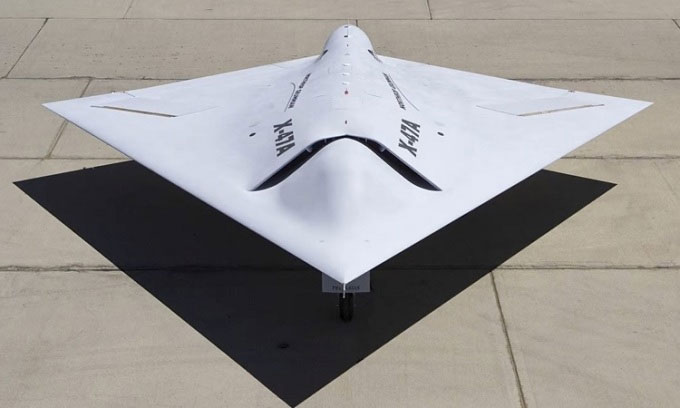A Chinese research team has developed and tested a prototype of a supersonic engine based on a bold design by a NASA scientist from over two decades ago.
Unlike most supersonic aircraft that mount engines on the belly, the Two Stage Vehicle (TSV) X-plane designed by Ming Han Tang, a former chief engineer of NASA’s supersonic program in the late 1990s, operates with two separate engines on either side. These engines can function like conventional turbine jet engines at low speeds and switch to supersonic mode when flying at speeds of Mach 5 or higher.

Boeing Manta X-47C aircraft in the program to validate Tang’s design. (Photo: SCMP)
The aerodynamics of the dual-engine design are quite complex, and several critical issues, such as whether the engines activate after transitioning to supersonic speeds, remain unresolved. The U.S. government halted the Boeing Manta X-47C program aimed at testing Tang’s design in the early 2000s due to technical challenges and costs. Professor Tan Huijun and his team at Nanjing University of Aeronautics and Astronautics in Jiangsu Province, eastern China, have constructed a prototype of the TSV with air intakes on both sides.
Tan tested the prototype in a wind tunnel simulating flight conditions from Mach 4 to Mach 8 (4,939 – 9,878 km/h) for several seconds. The engines could start under some of the most extreme flight conditions, just as Tang predicted. The design has attracted significant attention because understanding its operating mechanism could provide important insights for the development of supersonic aircraft and engines, according to a report published on December 5 in the Journal of Propulsion Technology by Tan and his colleagues.
Since the late 1980s, Tang led NASA’s supersonic flight research program while overseeing collaborations with the U.S. Air Force. Tang left NASA in 1999 to become a consultant. He passed away in Williamsburg, Virginia, in 2018 at the age of 79. According to Tan and his team, Tang’s design is not without flaws. Computer simulations and experimental results indicate that strong turbulence can occur at certain angles of the air intakes, affecting flight stability. The design is also limited by the angle at which the aircraft can maneuver without obstructing the engines. Despite the feasibility of the dual-engine design with several advantages, many challenging issues still need to be addressed.
According to Yin Zeyong, the director of science and technology at the Aviation Engine Corporation of China in Beijing, the country is developing and testing turbojet engines capable of flying at Mach 3 – 4 (3,704 – 4,939 km/h) to complement or replace missiles on supersonic aircraft. Chinese authorities plan to build an aircraft that can carry 10 passengers to anywhere on Earth within an hour by 2035.
Despite numerous challenges such as the risk of overheating and complex structures, supersonic engines based on turbojet technology are a more viable and optimal option, Yin stated. In July, the U.S. Air Force awarded a $60 million contract to the startup Hermeus to develop a prototype aircraft with similar technology over three years. Hermeus’s Quarterhorse aims to achieve speeds of Mach 5 with a single engine.


















































